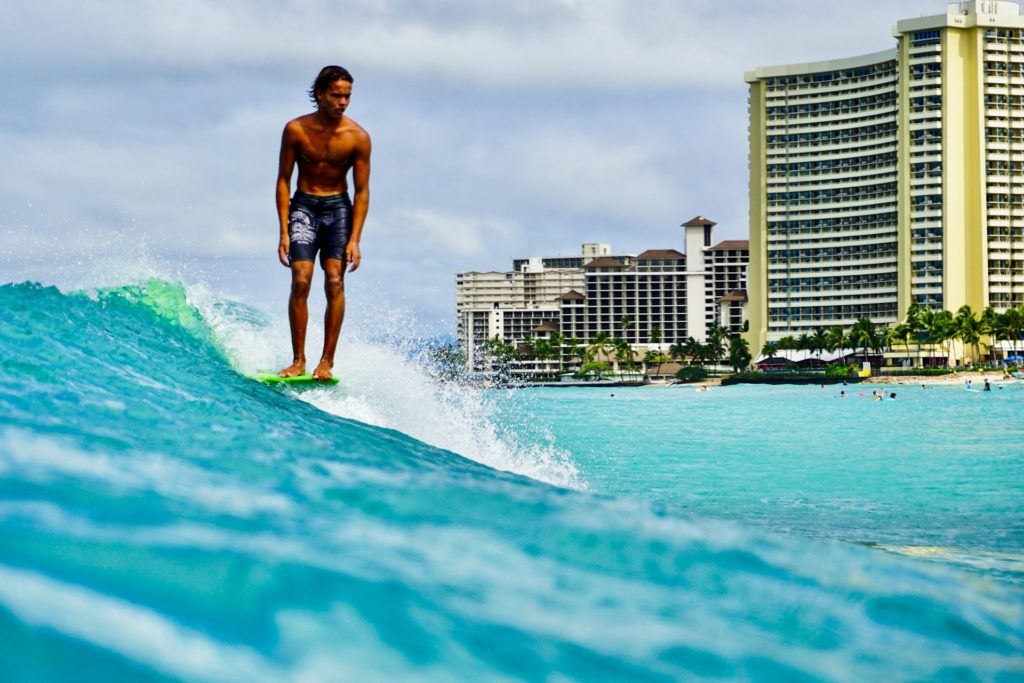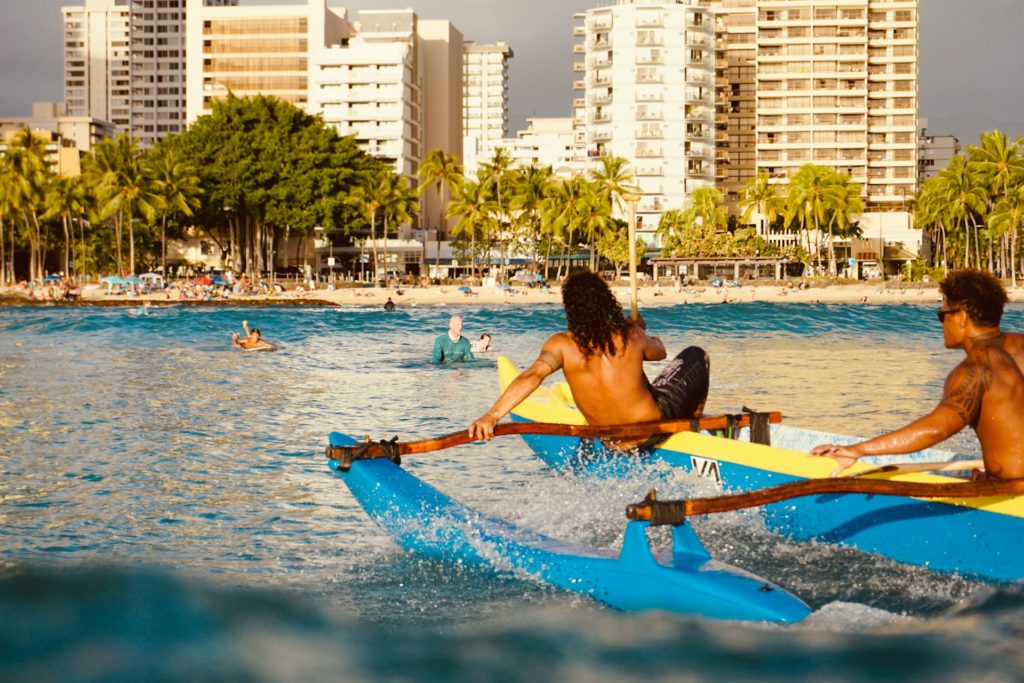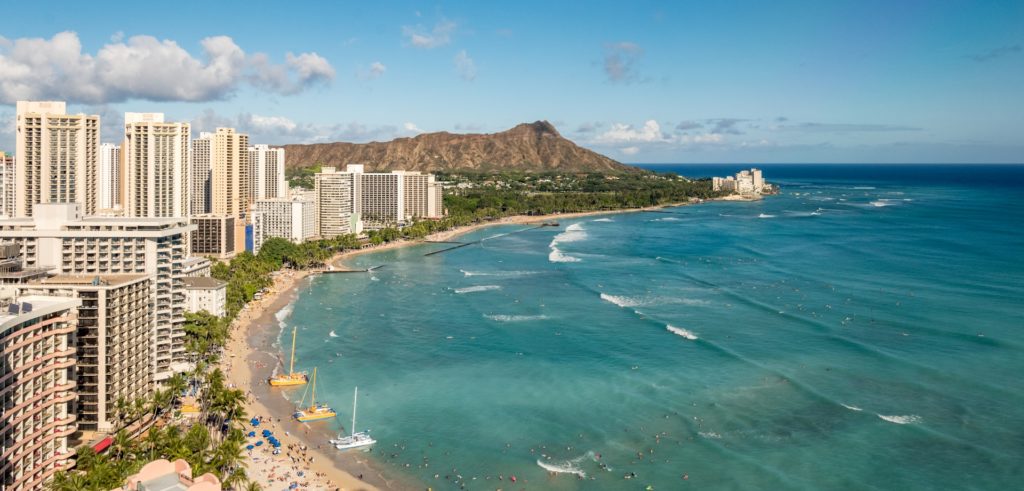Deciding the best time to visit Oahu, especially the vibrant Waikiki, depends on what you’re looking for. For fewer crowds and potentially lower room rates, shoulder seasons like late spring and early fall are ideal. Despite occasional rain showers, average temperatures during these months are comfortable for beach-going and exploring the island. Meanwhile, the summer season brings more visitors to Waikiki’s south shore, with its best beaches and bustling atmosphere.
Visiting Hawaii is a dream for many, and Waikiki doesn’t disappoint at any time of the year. Hiking trails are accessible year-round, and waves on the north of the island are a surfer’s delight in winter. However, visitor arrivals peak during winter and summer, so planning can ensure you get the most out of your Hawaiian adventure.
Seasonal Overview: Waikiki at Different Times of the Year
The best time to visit Oahu often depends on personal preferences. Shoulder seasons offer a balance of pleasant weather and value, with fewer rain showers and moderate average temperatures. Summer season can be hot, and room rates tend to rise with the temperature.
Waikiki in Spring: Blooms and Beaches
As winter fades, Waikiki welcomes spring with open arms. The air is filled with the scent of tropical blooms, and the beaches start to buzz with life. It’s a time when the island shakes off any remaining chills, and visitors can enjoy the warming weather without the summer crowds.
Outdoor activities abound, from snorkeling in the clear waters to strolls along the beach at sunset. Spring in Waikiki is a sweet spot for those looking for a mix of relaxation and adventure in a less crowded setting.
Waikiki in Summer: Sunshine and Surf
Summer in Waikiki is the epitome of the island’s sunny reputation. The dry season ensures that beach days are rarely interrupted by rain, and the surf is inviting for swimmers and paddle boarders alike. The longer days mean more time for sunbathing, shopping, and experiencing the local food scene.
Visitors during this season will find Waikiki buzzing with energy. From early-morning jogs along the shore to late-night luaus, there’s an infectious vibrancy that makes summer an exciting time to visit.
Waikiki in Fall: Cultural Celebrations and Calmer Crowds
Fall in Waikiki is a hidden gem, offering a tranquil escape with the bonus of cultural festivities. As the summer crowds dwindle, visitors can enjoy a more relaxed atmosphere. The ocean remains warm, perfect for days spent at Hanauma Bay, where the snorkeling is some of the best on the island.
This season also brings unique events that showcase Hawaii’s rich heritage, giving travelers a deeper look into the local culture. From food festivals to traditional music and dance, fall in Waikiki is a feast for the senses.
Waikiki in Winter: Whales and Waterfront Wonders
Winter in Waikiki is a marvel, with majestic whales making their annual visit to the warm Hawaiian waters. The waterfront becomes a stage for nature’s wonders, offering visitors a chance to witness these magnificent creatures. The festive season also adds a tropical twist to holiday celebrations, with palm trees adorned with lights and Santa arriving by canoe.
While the north shore sees impressive waves, Waikiki remains a haven for those looking to swim or learn to surf in gentler waters. The cooler temperatures make it a great time for hiking and exploring the island’s natural beauty.

Monthly Breakdown: What to Expect in Waikiki
Visiting Oahu each month brings its own unique experiences. From seasonal weather patterns to special events, understanding what to expect can help tailor the perfect Hawaiian vacation.
January in Waikiki: Start Your Year in Paradise
January in Waikiki is a blend of vibrant holiday spirit and a return to tranquility as the festive crowds disperse. The weather is cooler, so packing a light jacket for evenings is smart. The island’s lush greenery is at its peak after the winter rains, creating a beautiful backdrop for all outdoor adventures.
February in Waikiki: Valentine’s Day and Whale Encounters
February is a time for romance and nature in Waikiki. Couples can enjoy Valentine’s Day with beachside dinners and sunset cruises. A light jacket is still recommended for the cooler nights. Whale watching is at its best, and the variety of outdoor activities ensures there’s something for every visitor to enjoy.
March in Waikiki: Spring Break Energy
March marks the start of spring break, infusing Waikiki with youthful energy and a party atmosphere. The weather begins to warm up, inviting visitors to spend their days on the sun-soaked beaches or trying out water sports. It’s a time of celebration and excitement, perfect for those looking to join in on the fun.
April in Waikiki: Easter Celebrations and Serene Beaches
April in Waikiki offers a peaceful retreat with Easter celebrations adding a festive touch. The beaches are less crowded, providing a serene environment for relaxation and family fun. The ocean’s embrace is warm, and the island’s beauty is on full display as nature blooms.
May in Waikiki: Lei Day Festivities and Ideal Temperatures
May is a beautiful time in Waikiki, with Lei Day festivities kicking off the month in a colorful display of Hawaiian culture. The temperatures are ideal for all-day beach outings and exploring the island’s attractions without the intense heat of summer.
June in Waikiki: Beginnings of Summer Vibrance
As June arrives, so does the vibrance of summer. Waikiki begins to buzz with activity, from surfing competitions to outdoor markets. The days are longer and sunny, perfect for making the most of every moment in this tropical paradise.
July in Waikiki: Independence Day Festivities and Peak Tourism
July in Waikiki is a time for celebration, with Independence Day bringing fireworks and festivities. The best weather for beach activities is now, but be aware that rental cars and hotel prices may be higher due to peak tourism. Planning can help you find the best deals and avoid the crowds.
August in Waikiki: Hot Weather and Hotter Events
The heat of August doesn’t slow down Waikiki. The hot weather is perfect for early-morning swims and late-night walks on the beach. The island’s calendar is full of events, from music festivals to culinary showcases, ensuring that every day is filled with new experiences.
September in Waikiki: Fall’s Secret Sweet Spot
September in Waikiki is a hidden gem, offering a respite from the larger summer crowds. The weather remains warm, perfect for beach days and outdoor adventures. Meanwhile, the ocean begins to stir, giving early hints of the best waves for surfing. Oahu celebrates this transitional period with smaller, more intimate events, and the absence of summer’s peak prices makes it a wise choice for budget-conscious travelers. One can enjoy the serene beaches without the hustle, making it an ideal time for a peaceful Hawaiian retreat.
October in Waikiki: Halloween Fun and Cultural Events
October brings a festive spirit to Waikiki with Halloween celebrations and an array of cultural events. The month is marked by a perfect blend of warm weather and the excitement of upcoming festivities. Visitors can experience the island’s traditions, as Oahu celebrates its heritage with music, dance, and food. The month culminates in thrilling Halloween parties and fireworks displays that light up the night sky, providing a unique tropical twist on the autumnal holiday.
November in Waikiki: Thanksgiving Getaways and Surf Competitions
November in Waikiki is a time for gratitude and grand waves. The North Shore starts to come alive with some of the best waves in the world, attracting experienced surfers and spectators alike. Surf competitions pepper the calendar, offering exhilarating displays of skill and prowess. Oahu celebrates Thanksgiving with feasts and festivities that give a Hawaiian flavor to the holiday, making Waikiki an unforgettable destination for a November getaway.
December in Waikiki: Celebrate the Holidays in Hawaiian Style
December in Waikiki is a festive fusion of holiday cheer and Hawaiian culture. The month features the Prince Lot Hula Festival, showcasing the largest non-competitive hula gathering on the islands. For those seeking to catch a wave, the best prices on accommodations can be found early in the month, and experienced surfers can revel in the challenging winter swells. Celebrating the holidays in Waikiki is a warm and enchanting experience, far from the chill of a mainland winter.

Special Events and Activities
Waikiki and the island of Oahu are vibrant with special events throughout the year. Visitors in late April to early May can experience Golden Week, a series of Japanese holidays that bring a festive atmosphere to the island. The Honolulu Festival, typically held in March, celebrates the Pacific Rim region with parades, dance performances, and cultural exhibits. Ala Moana Beach Park becomes a place of reflection during Lantern Floating Hawaii, a poignant Memorial Day event that honors loved ones and promotes peace.
Throughout the year, the island of Oahu hosts a variety of activities that cater to all interests. From the Waikiki Spam Jam, a street festival celebrating one of Hawaii’s favorite foods, to the charity golf tournament held in the summer, there’s always something happening. The Aloha Festivals in September highlight Hawaiian heritage with music, dance, and traditional ceremonies. For surf enthusiasts, the winter season brings the Van’s Triple Crown of Surfing, where spectators gather seeking big waves and breathtaking competition.
Whether it’s planning to visit during a specific event or simply soaking in the local culture, the island’s calendar is packed with opportunities to explore and engage. Always check ahead for the dates of these events, as they can be the highlight of a trip to Oahu, providing an authentic glimpse into the island’s rich tapestry of traditions and celebrations.
Travel Tips for the Savvy Visitor
When planning a trip to Oahu, understanding the seasons is key. The peak season, from mid-December to April, offers warm weather but also brings the most visitors. Conversely, the shoulder seasons, May through June and September through mid-December, offer a balance of pleasant conditions and fewer crowds. Visiting during the rainy season, from November to March, can mean more rain showers but also lush landscapes and vibrant waterfalls. Tropical storms are rare, but it’s wise to stay informed about Hawaii weather during your visit.
For those seeking to attend specific events like the Honolulu Festival or Lantern Floating Hawaii, it’s crucial to plan and book in advance, as these draw large numbers of visitors. Additionally, Golden Week and other Japanese holidays can result in busy periods, with increased demand for accommodations and services. Always remember, no matter when your trip to Oahu is, the tropical climate ensures that the island’s beauty is on full display year-round, making any time one of the best times to visit this tropical paradise.
Frequently Asked Questions
The rainy season in Waikiki typically occurs from November to March. During this time, you can expect occasional rain showers, which often are short and followed by sunshine. The rain brings out the lushness of the island, making it a beautiful time to explore Oahu’s natural beauty.
Yes, there are several! The island of Oahu hosts events like the Honolulu Festival in March, the Aloha Festivals in September, and Lantern Floating Hawaii on Memorial Day. Each offers unique experiences that showcase Hawaiian culture and traditions.
The best times for warm weather in Waikiki are during the shoulder seasons, which run from May to June and September to mid-December. During these times, the weather is typically warm and sunny, with fewer tourists than during the peak season.
Absolutely! While the peak season, from mid-December to April, sees the highest numbers of visitors, Waikiki’s charm and attractions can still be thoroughly enjoyed. It’s simply recommended to book accommodations and activities in advance.
Preparation for tropical weather includes packing lightweight clothing, sunscreen, and a rain jacket for unexpected showers. Always stay hydrated and check the local forecast for any tropical storm warnings during your visit.
Concluding Thoughts
Waikiki is a destination that offers year-round appeal, with each season bringing its own unique experiences. From the vibrant cultural festivals to the stunning natural beauty, the islands of Hawaii are a tropical paradise waiting to be explored. Whether you’re looking for adventure, relaxation, or cultural immersion, Waikiki has something for everyone.
While visiting, take the opportunity to pay respects at Pearl Harbor, a site of great historical significance. Ultimately, the best time to visit Waikiki is whenever you can immerse yourself in the aloha spirit and create unforgettable memories in this Hawaiian haven.
